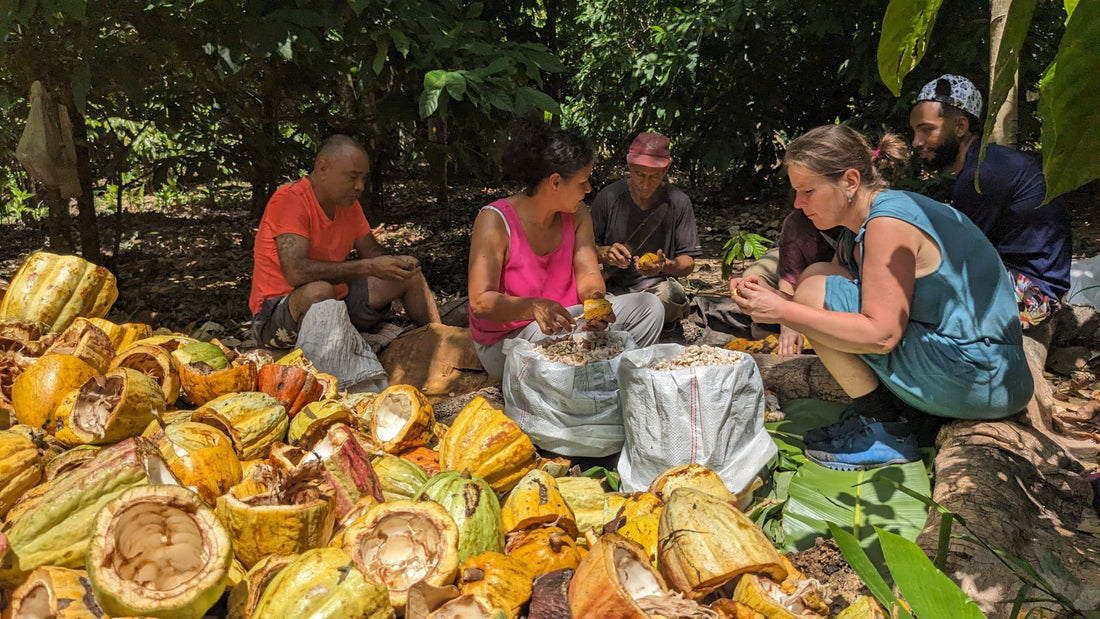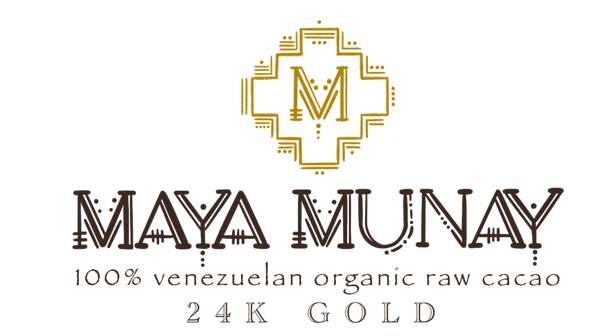
Part 7: From tree to ceremony
Share
During our time in Macuro, we were able to learn soooo much about cacao. In the jungle, we connected with the plant on every level. We prayed to the trees; the burned, dead trunks protected us from mosquitoes, their ashes protected us from the sun.

For the harvest, we split into two teams. One team walks through the forest in pairs, with one person removing the ripe fruit from the tree with a long stick. The other person picks them up and brings the filled bags to the collection point.

This is where the second team sorts the fruit into three categories. One category is rejected, and the other two will be processed in the future. The fruit is already sorted here, as there are different classifications depending on quality, which determine the payment. We open the fruit with a machete and remove the cocoa beans, encased in delicious white pulp. The fruit is so beautiful and colorful. Each one is as unique as its effect on our hearts.


After a few hours of work, the donkeys are loaded with sacks of cocoa beans and accompany us to the village.

In the backyard of Peloma and Miguel's house, Andrés shows us the fermentation process. The beans are gently layered in wooden crates lined with palm leaves.
Depending on the fermentation method, they are carefully moved after 24 or 48 hours, for example, so that every bean can undergo an equal fermentation.
The pulp, the liquid within, and the covering of the crates create temperatures that allow the cocoa to ferment. Fifty cocoa beans are removed daily and opened with a clean cut to assess the fermentation status. This is a major factor in quality and payment. It's a truly exciting process, and Andrés and Marleen explain everything to us with passion.


We are very grateful that they share all their knowledge with us.
After fermentation, the cocoa beans are dried. They are usually spread out on cloths or foil on the street so that the sun can dry them naturally. The process takes several days. The cocoa is spread out in the morning and collected again in the evening. The same process occurs the next day.

Once the cocoa is dried, the cocoa beans are ready for sale/export. For this, traders pay people a price per kilo depending on the quality.
We're allowed to continue the process by heating a pan. Only when the pan is fully heated do we gently add our beans to roast. The beans are gently roasted while constantly stirring and checking the temperature.
Now our patience is required.
The roasted and cooled beans now need to be peeled.

With the help of the village kids, we only need a few hours. ;-)
The shelled beans are then placed in a hand-operated mill. Here, the beans are ground finely in two to five passes, each pass becoming slightly finer, until the cocoa mass is formed.

It's incredible how many hours, days, and months of work go into making the cocoa mass. Truly impressive. So much love. For the cocoa and for the details.
We all prepare our cocoa together for the ceremony.
With the prepared cocoa, we go to the river and prepare a beautiful ceremony site.

We thank all the entities and energies involved. For the cacao and for allowing us all to be in the optimal place for us at this moment. The cacao has brought us together here, and we are learning and growing with everything that reveals itself and wants to be seen.
